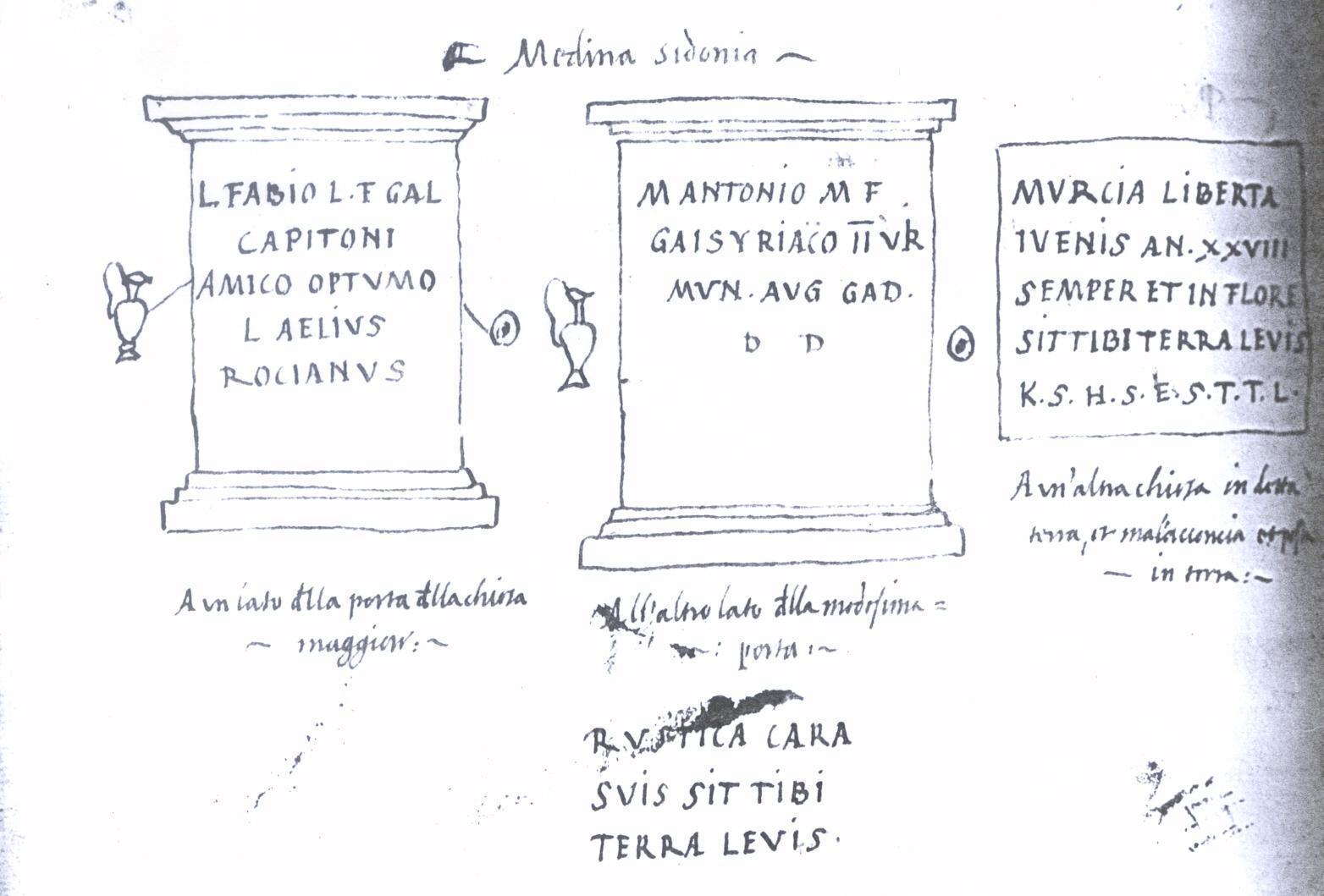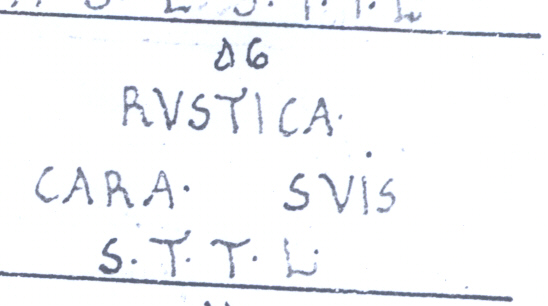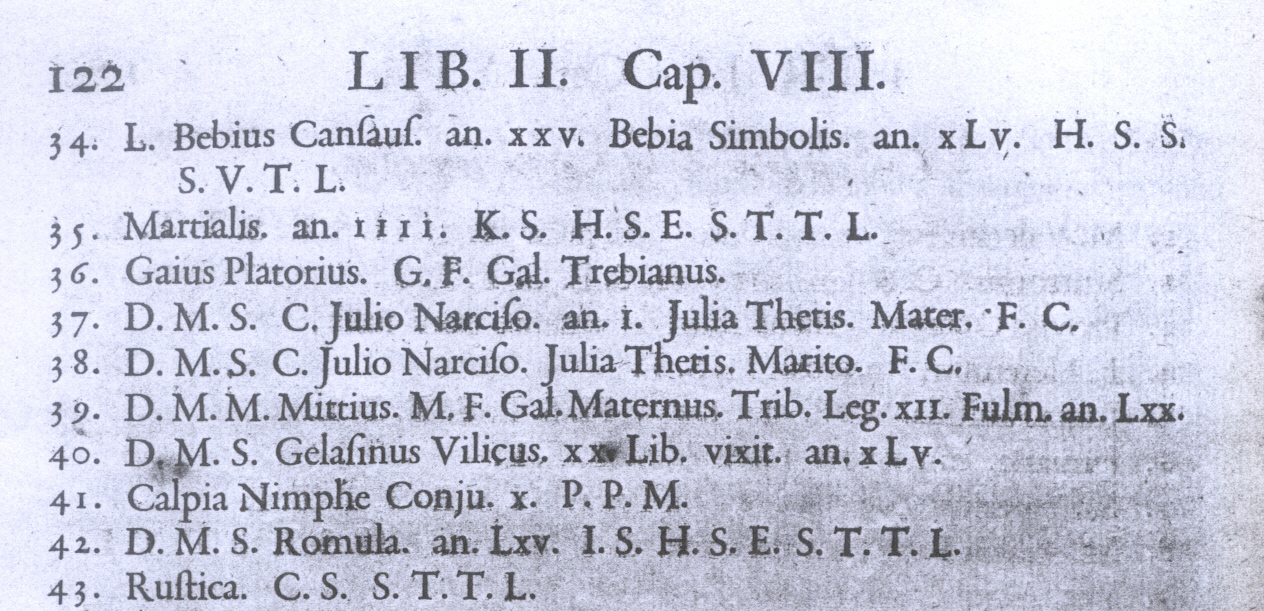Epitaph of Rustica
Reference CIL II 1882 y 5118 | Description | Lyrics | Location | Chronology | Epigraphic edition | Translation | Apparatus | Comentary | Type of verse | Text divided into verses and metric signs | Images | Bibliography | Link to DB | Author |
Epitaph of Rustica
Description
- Idno filename 22/01/0032
- Type of inscription: Sepulcralis
Location
- Place of discovery: Found in Medina-Sidonia.
- Geolocation
- Location with Modern Nomenclature España / Cádiz / Medina-Sidonia
- Location with Old Nomenclature Hispania / Baetica / Gaditanus / Gades / Asido
Chronology
- Inscription's dating: Between year 70 and year 130
- Dating explanation: From the formula cara suis in Gades, it can be dated to the end of the 1st c. and beginning of the 2nd c. AD.
Type of verse
- Type of verse: Dactílico (pentámetro)
- Verse/line correspondence: No
- Prose/verse distinction: No
Epigraphic edition
Rustica cara suis sit
tibi terra levis
Text divided into verses and metric signs
Rustica, cara suis, sit tibi terra levis. lkk|lkk|l||lkk|lkk|~
Translation
“Rustica, beloved by her own, may the earth rest lightly on you.”
Bibliography
Anonymvs Tavrinensis, ms. saec. XVI, 62, f. 678v et 682r (inde Hübner II 1882 et 5118 [inde Bücheler, CLE 1124, cuius exemplum in linguam Hispanicam vertit Fernández Martínez 1998-99; Cholodniak 1904, 1218; Vives, ILER 2936; González Fernández, IRCa 22 et 278– ex Hübner, bis invite transcripsit –]); Martín de Haya, posteriore s. XVI dimidia parte, BCC ms. 56-4-8, 114 et apud Concepción 1690, 121; ex eis Gómez Pallarès – del Hoyo – Martín Camacho 2005, 230–235; Martín Camacho, CLEB ES, CA2, qui in linguam Hispanicam vertit. – Cf. Hernández Pérez 2001a, 172; del Hoyo 2002b, 162.
Comentary
The original ordinatio was transmitted in two different forms by the main source, the Anonymus, and therefore we cannot be certain what the original form was. Correct pentameter, with the name of the deceased perfectly fitted. Clearly formulaic content following the regional pattern: name of the deceased + carus/-a suis + sit tibi terra levis.
Possibly a true carmen epigraphicum purposely inscribed to distinguish it from formulaic prose epitaphs, or else actually a prose epitaph which happens to have a perfect metrical structure (cf. Gómez Pallarès-Del Hoyo-Martín Camacho 2005, 233-235): the fact that abbreviation has not been used in the text reflects the attempt to use the prosodic features of the cognomen of the deceased woman to present a text that sobrepasa la tendencia meramente formular y prosaica (goes beyond the merely formulaic and prosaic tendency) Del Hoyo 2002b, 162. There are parallels where formulaic texts are written without abbreviation in order to make it clear that they are poetic compositions: CA10, where the formula s.t.t.l. appears twice, first within the carmen, not abbreviated, and the second as a mere formula, and therefore abbreviated: semper et in flore / sit tibi terra levis / k(ara) s(uis) s(it) t(ibi) t(erra) l(evis); CA3, where the praescriptum ends with the formula h.s.e.s.t.t.l., while after the formula it appears partly expanded and even augmented: te rogo praeteriens cum | legis ut dicas sit tibi t(erra) l(evis); cf. also CA6.
Author
- Author:J. Martín Camacho
- Last Update2023-12-04 16:49:04
You can download this







